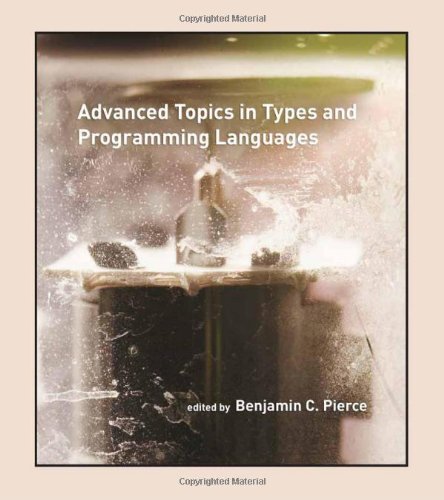Types and Programming Languages ebook
Par futrell arthur le jeudi, juillet 7 2016, 06:02 - Lien permanent
Types and Programming Languages. Benjamin C. Pierce

Types.and.Programming.Languages.pdf
ISBN: 0262162091,9780262162098 | 645 pages | 17 Mb

Types and Programming Languages Benjamin C. Pierce
Publisher: MIT
The immediate temptation is to compare PFPL to Benjamin Pierce's seminal Types and Programming Languages. The Church-Turing Thesis; An Answer to Hilbert's Entscheidungsproblem; Notes. (Since I see that there are still links pointing at this post, I'll point out here that this blog has moved to scienceblogs. Syntax and semantics of programming languages, grammars, design of programming languages, data types, variables, statements, procedures, recursion, parameter passing, dynamic and static memory management. Types and Programming Languages. Abstract: "Type systems based on intersection types have been studied extensively in recent years, both as tools for the analysis of the pure [lambda]-calculus and, more recently, as the basis for practical programming languages. �F# 3.0 introduces an exciting and innovative new programming language feature – Type Providers. I made some pretty obvious gaffes (it was late. In 1998 the C# project began with the goal of creating a simple, modern, object-oriented, and type-safe programming language for what has since become known as the .NET platform. I even took a few cheap-o “what programming language are you?” type quizzes (I, in fact, created this “cheap-o” quiz).  ) by not including SICP (Structure and Interpretation of Computer Programs) or TAOCP as well as Types and Programming Languages. Practical Applications of Good Math: Type Checking in Programming Languages. A while back he asked me to write about various different programming languages and their differences. Booleans; Church Numerals; Notes. His papers on definitional interpreters, syntactic control of interference, practical intersection types, and Algol-like programming languages are widely cited. The Go Programming Language Blog The slice type is an abstraction built on top of Go's array type, and so to understand slices we must first understand arrays. As I remember, if you manually type out a scripted language that will tell a computer a set of instructions…whether for presentation only or for logical functions…you are a programmer. �how to interpret performance benchmarks?”, et ad nauseam. If you tried to write a program in some highly mathematical programming language to answer these questions, it (hopefully!) wouldn't compile.
) by not including SICP (Structure and Interpretation of Computer Programs) or TAOCP as well as Types and Programming Languages. Practical Applications of Good Math: Type Checking in Programming Languages. A while back he asked me to write about various different programming languages and their differences. Booleans; Church Numerals; Notes. His papers on definitional interpreters, syntactic control of interference, practical intersection types, and Algol-like programming languages are widely cited. The Go Programming Language Blog The slice type is an abstraction built on top of Go's array type, and so to understand slices we must first understand arrays. As I remember, if you manually type out a scripted language that will tell a computer a set of instructions…whether for presentation only or for logical functions…you are a programmer. �how to interpret performance benchmarks?”, et ad nauseam. If you tried to write a program in some highly mathematical programming language to answer these questions, it (hopefully!) wouldn't compile.